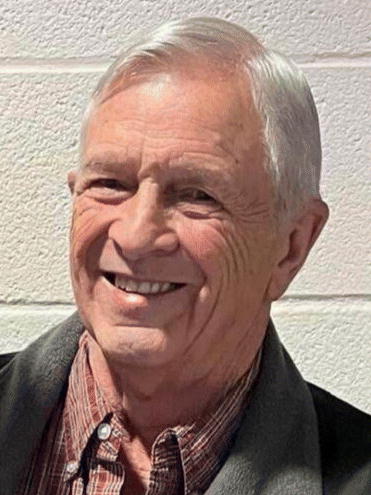Health Department Provides Updates on Renovation, and Harm Reduction Programs at Chamber of Commerce Lunch
Published 9:59 am Friday, July 19, 2024

- Harm Reduction Director Shauna O’Nan, and Coordinators Hannah Ard and Rebecca Smith show a presentation slide on the Smart Recovery tools and techniques program. (Photo by Gillian Stawiszynski)
|
Getting your Trinity Audio player ready...
|
Guests at a recent chamber of commerce at lunch the Jessamine County Health Department (JCHD) located on 210 E Walnut Street is undergoing an expansion. The 1,300 sq ft community room will be expanded into a 5,000 sq ft community room and will include offices for the JCHD HANDS program, which is a program that provides in-home assistance to new and expecting parents.
Melinda Barkley is the Communications and Health Education Coordinator at the Health Department. The JCHD Executive Director Ann Stevens couldn’t be in attendance, so Barkley was her stand-in.
The JCHD HANDS program is currently sharing what used to be a storage room, according to Barkley. With COVID, the program staff started doing online visits and while abiding by HIPAA laws, the situation wasn’t conducive to the small space. The community room was also previously used as a COVID response space in 2020, and it proved to be too small.
In addition to creating more space for the Harm Reduction Team, the Syringe Exchange Program, and the HANDS program, the community room is going to hold 154 people total. It is something Barkley is “particularly excited about. It will allow in-person, virtual, and hybrid meetings as needed in this space. It’s just a large space where we can hold classes and training and community events (in).”
The entire project has a price tag of about $2.4 Million, but $1.7 Million was covered through grants, including an epidemiology and capacity grant that paid for the majority of the expanded community room. “In the event of a pandemic or another emergency response situation we would be able to turn that into a response center,” Barkley said, knocking on the wooden podium to not jinx it.
Getting this covered through grants, Barkley said, is “Really exciting and just a huge relief. If we can find other ways to pay for it, it’s a burden that our taxpayers don’t have to bear.”
Construction started in August 2023 and is set to be completed next month.
The rest of the meeting surrounded the JCHD’s fastest growing program– its Harm Reduction Program.
Harm Reduction Director, Shauna O’Nan, and Harm Reduction Coordinators Hannah Ard and University of Kentucky affiliate Rebecca Smith informed the luncheon guests on what it is the harm reduction program does.
According to Ard, “Harm reduction includes a spectrum of strategies such as: safer [drug] use, managed [drug] use, abstinence, and meeting people who use drugs where they’re at.”
Under the Harm Reduction Team is the Jessamine Transitions Program, the Mobile Harm Reduction Unit, the Syringe Exchange Program, and Naloxone in Jessamine County. Detailed information on all of these programs can be found at https://jessaminehealth.org/harm-reduction/.
One of the Harm Reduction programs is the Jessamine Transitions Program. It’s a three-year diversion program and once completed, participants can get a Class D felony expunged from their record. “It’s very hard to get a lot of basic needs when you have a felony on your record,” said Ard. This program allows participants to heal, and start a new beginning. Most of this program’s participants come from the circuit court system.
The Harm Reduction team provided local statistics to the audience. In 2017, Jessamine County ranked sixth in overdose deaths per capita at 56.2 drug overdose deaths per 100,000 people. In 2018, there were 728 drug-related arrests in the county. Also within their first two weeks, former inmates were 40 times more likely to die of an opioid overdose than someone in the general population.
“[With this program,] we were able to build a really great relationship with law enforcement so now anytime there’s a drug related arrest we have law enforcement come to our office… and we do what we can.” Ard said.
The Jessamine Transitions program takes about six months and requires a court order, 26 SMART recovery classes, and weekly check-ins. To complete the program, all fines must be paid by the participant, they must pass a drug test, and have proof of employment with no other pending charges.
SMART recovery teaches participants skills and tools they can apply to their real life circumstances, according to O’Nan, and she speaks from experience after being in recovery for almost six years. “Addiction isn’t just a substance use disorder, it involves every aspect of who someone is,” she said. Participants are able to build and maintain motivation, cope with urges and cravings, identify and begin to align with their core values again, manage tough feelings and behaviors, and live a balanced life.
Nicholasville has four SMART recovery meetings a week. With in-person, hybrid, and strictly virtual options. The program has no spiritual requirement, as can be common in recovery programs and support groups. Although there are people who desire the underpinnings of God and faith in their recovery process, having no secular option discourages some people who would otherwise participate. “a lot of people in active use have an issue with spirituality and we judge ourselves right out of the room.. SMART recovery doesn’t include that. I don’t tell you you have to believe in that door knob to become sober.”
Transportation is a huge barrier for a lot of these participants, so Ard says the health department does what it can to help with transportation, and connects its participants with any other resources they need– including plugging them into local assistance programs like Shepherd’s House which offers recovery programs, housing, and clean clothes.
“Recovery without somewhere to lay your head at night is pretty difficult,” Ard said.
The team also helps people in the community get identification cards, since it is a major boundary to people trying to access basic needs, according to Smith. Assistance with getting to and from medical appointments and mental health help are also things the Harm Reduction team can provide for people in need.
O’Nan showed the crowd a photo of a participant in the transitions program, a young lady stood in between O’Nan and Former Harm Reduction director, Sydney Bisschop.
“She’s been sober now going on three years and she is raising her fifth child in a drug-free environment. She did lose custody of her other four children. That is what harm reduction can do for somebody,” O’Nan said. “Our syringe exchange booth is really the landing spot for a lot of people. We give them an even exchange rate, they have to get rid of their old equipment when we give them new ones.”
People part of a syringe exchange program are 5 times more likely to seek treatment. We also encourage oral prep use. It’s a medication that can prevent HIV through sexual risk or injection/drug use.” Smith said.
The syringe exchange program also goes to “high-risk areas” with the Mobile Harm Reduction Unit. Naloxone can also be found all throughout Jessamine County. It’s an important drug that reverses overdoses. The Harm Reduction team at the JCHD can train you on how to use it, and also help you install a Naloxone box in your business. The drug can already be found in boxes around town at the MedSave pharmacy in Nicholasville, all the city and county’s parks, pharmacies, and at gas stations. “We really just want everyone to update their first aid kit with Naloxone,” O’Nan said.
Since 2022, Jessamine County has had a 28 percent decrease in overdose deaths. “That’s just Jessamine County alone, the state of Kentucky was a 9.2 decrease all together,” O’Nan said.
The ASAP agency for substance abuse policy is a community board that anyone can be a part of. It meets on the third Wednesday of the month at 1 p.m. Reach out to anyone at the Harm Reduction Team or the Health Department and they will get you information on how to attend.



